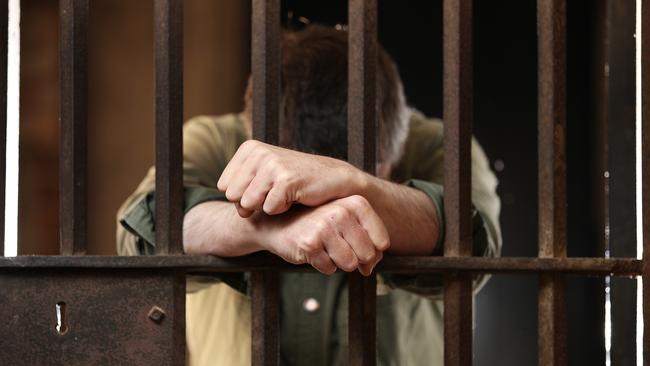SEVENTY-four years have passed since Frederick Henry Thompson was hanged by his neck until dead at the Campbell Street gallows.
The paedophile and child murderer was the last person in Tasmania to be punished by death, with the state officially relinquishing capital punishment 22 years later in 1968.
Given serious criminals like Thompson can no longer be executed, what can the government do with those whose crimes are so horrific – or so dangerous – that society cannot bear the thought of their eventual release from prison?
It’s rarely used and highly controversial, but the state’s Criminal Code provides a method for judges to lock up a criminal in jail until the day they die, by making what is known as a “dangerous criminal declaration”.
Here are the backstories behind the criminals the Crown argued were the very worst in Tasmania, and who were ordered to spend the rest of their days rotting behind bars at Risdon.
RELEASED OR DECEASED?
Jamie Gregory McCrossen, 48
Antique shop robber
In 1990, 18-year-old McCrossen burst into the Anchorage Antique store at Sandy Bay and pointed an antique pistol in the face of store owner Francis Christensen.

A year later, he was declared a dangerous criminal by then-Chief Justice Guy Green after the youth sent death threats to Mrs Christensen from Risdon Prison, stained with his blood.
In 2013, McCrossen applied for the declaration to be discharged, but failed.
Finally in 2018, after 27 years in jail, McCrossen finally got his wish to “get out there and do good deeds”.
Justice Helen Wood ordered the declaration be lifted, slamming the length of time he’d spent behind bars as “Dickensian”.
At the time, prisoner advocate Greg Barns criticised the length of his incarceration as a “case of gross human rights abuse”.
Mark “Chopper” Read, deceased at 58
Underworld standover man

In 1991, the infamous and earless standover man known as “Chopper” Read moved to Tasmania to get away from a life of crime in Melbourne.
It didn’t last long.
He was locked up indefinitely at Risdon Prison in 1992 after shooting Sidney Michael Edward Collins outside his Evandale home.
While a psychiatrist told the Supreme Court of Tasmania that Read wasn’t suffering a clinical mental illness, Justice William Cox took a dim view of the notorious criminal’s history.
“One is loath to exercise these powers save in a very clear and exceptional case,” he said, deeming Read a dangerous criminal.

While locked up at Risdon, Read fell in love with Hobart ATO employee Mary-Ann Hodge, who visited him regularly in jail after reading one of his blockbuster autobiographical books.
His dangerous criminal status was revoked in 1997, and the following year he was released from jail to live on a farm at Richmond with his new wife.
The pair had a son, Charlie, but the marriage ended in 2001 when Read complained that “life in Tasmania was just too slow”.
Thomas Hueston, deceased at 55
Homeless boarding house arsonist
Perhaps the saddest instance of a man who died in Tasmania’s prison system as a declared dangerous criminal was the case of Thomas Hueston.
Represented in court by Martin Bryant’s disgraced lawyer John Avery, Hueston continually set fire to his beds, bed linen and mattresses at various homeless shelters across Hobart.
He wanted to go back to jail where he’d be housed, fed and given a ration of cigarettes.

Even though no-one was ever hurt, Justice Christopher Wright deemed the homeless man’s episodes of fire-lighting were acts of violence given the risk he posed to people’s lives.
When his dangerous criminal status was declared in 1995, Hueston threw his arms in the air in a victory salute.
Hueston started setting fires in 1985, while he was boarding at the St Vincent de Paul night shelter, repeating the behaviour at the Order of St Basil boarding house, Roseville Guest House, Flint House and other homeless shelters.
Hueston died in custody 10 years later, aged 55, from natural causes.
IRS, deceased, age unknown
Violent rapist
A “sexual deviant” whose name has not been released by the justice system was declared a dangerous criminal in 1995 after a series of horrific rapes.
Earlier that year, he’d entered his victim’s home by pretending he wanted to retrieve his jacket, but violently raped her instead.
IRS had been previously jailed in 1989 for a “serious and sustained violent and sexual assault on a 14-year-old girl”.
But five months after they got out of jail, IRS abducted, raped and assaulted a seven-year-old girl.
The late Wilfred Lopes, Tasmania’s long-serving senior forensic psychiatrist, initially held “high hopes” for IRS’ rehabilitation, but a few years later recommended chemical castration.
IRS made an application in 2012 to have their status discharged, but this was rejected by the Supreme Court of Tasmania.

STILL LOCKED UP
Colin John Sparkes, about 62
Sadistic rapist
In the early hours of one morning in 1983 outside a Launceston nightclub, Sparkes watched a teenage girl have an argument with her boyfriend and walk off upset.
He followed her.
As the 17-year-old walked past Launceston Matriculation College, Sparkes grabbed her from behind, knocked her to the footpath, and dragged her into the school grounds.
Sparkes subjected the girl to a terrifying 90 minutes – stripping her naked and tying her up before blindfolding, whipping, bashing and repeatedly raping her.
He drew all over her body with her lipstick and eyeliner before performing more disgusting and degrading acts upon her and leaving her still blindfolded, naked and bound in the college grounds.
Two years later, Sparkes raped a woman in Queensland who was eight months pregnant after breaking into her home.
He was finally brought to justice in 1996 for the Launceston rape, with Justice Peter Underwood declaring him a dangerous criminal the following year.
Kevin Richard Bell, 73
Serial child rapist
Horror Glenorchy child rapist and “sexual psychopath” Kevin Bell put his hand up to be chemically castrated, rather than face the prospect of life in jail.

If Tasmania’s judiciary had said yes, Bell would have been the first Australian prisoner to undergo the punishment.
But Bell, who spent time in jail for repeatedly raping a girl aged 12 and one aged 10, and indecently assaulting girls aged three, six and 16, had his request refused and he was permanently incarcerated at Risdon instead.
He was declared a dangerous criminal in 1999 after committing an aggravated sexual assault just six months after being paroled for raping the 12-year-old.
Bell has made two applications to have his declaration discharged, but both have been rejected and he continues to rot behind bars.
Brendan James Freeman, about 48
Serial rapist
In 2003, Freeman brutally raped and beat a 43-year-old woman in an empty house in Launceston, leaving her with two black eyes, her entire body grazed, bruised and swollen, clumps of hair ripped out, and damage to her teeth – some of which had to be removed.
The 31-year-old had previously raped and hit a hearing-impaired woman in NSW during 1993, with the victim running for help naked into the street with a bleeding nose.
Two years later, he sexually assaulted a 14-year-old intellectually-disabled girl, with the child’s mother finding him in her daughter’s bedroom.

After serving time in a NSW jail, Freeman moved to Tasmania in 1997 and raped a woman after punching her several times about the head and face.
His NSW parole was revoked and he spent until 2003 in Risdon Prison. Just four months after his release, he committed the Launceston rape.
The Crown applied for a dangerous criminal declaration, with Justice Ewan Crawford readily agreeing that without containing him, Freeman would rape again.
Freeman remains in jail, and no application has been made to discharge the declaration.
Ian John Brumby, about 64
Rapist and violent recidivist
It was the last day of 2001 when New Town man Ian John Brumby stabbed his New Year’s Eve drinking buddy’s throat in a completely unprovoked attack.
Luckily, his mate survived the attack, but unfortunately, it wasn’t even Brumby’s worst crime.
During the 1970s, Brumby robbed a milk bar with a flick knife and injured its female worker, before raping and bashing a woman twice during the 1980s just seven weeks after he was released from prison.

In the 1990s, he fractured a woman’s skull and broke her arm while living in a squat.
The same decade, he attacked another woman on the street, smashing a beer bottle on her back, dragging her onto a nature strip and punching her to the head.
Two years later, Justice Peter Evans approved an application to declare Brumby a dangerous criminal given he presented “a constant danger to the community”.
Brumby has never made an application to discharge his status, so remains under lock-and-key.
Ronald William Barnard, about 80
Serial child rapist
Barnard’s litany of horrific child rapes beggars belief.
The paedophile of “limited intellect” – who always took steps to cover a child’s mouth to stop them crying out – was locked up for good in 2007 by Justice Peter Evans.
In 2007, then aged 66, Barnard befriended the mother of an eight-year-old boy and then offered to take the child to Kmart at New Town.

After the shopping trip, he took the boy to the Domain where he stuffed a handkerchief in his mouth and held his hand over his face – but the child managed to punch his way free and run to the highway for help.
In 1970, Barnard had tied a handkerchief around an eight-year-old boy’s face and forced his head into a gully trap – a wastewater drain fitting – before raping him. At the time, the crime was called “unnatural carnal knowledge”.
Then in 1993, he lured a six-year-old boy he didn’t know into a paddock, held his hand over his mouth and raped him.
In 2006, Barnard assaulted an 11-year-old girl by wrapping a handkerchief around her face and attempting to force her into a toilet cubicle.
Barnard is still alive and behind bars.
Jamie John Curtis
Jamie John Curtis – a “danger to society” – could soon find himself in the same class as just five other criminals in Tasmania who are locked up for life.
He’s been in Risdon Prison since 1986 – albeit with a short stint on parole – for murdering Glenorchy man Dean Allie, repeatedly raping his fiance Tameka Ridgeway, and abducting a 15-year-old schoolgirl.
At the time of his jailing, Curtis was diagnosed with severe anti-social personality disorder exacerbated by minimal brain damage, with Justice William Cox noting he would have previously been called a “psychopath”.
Justice Cox queried whether the Tasmanian community would be better served if Curtis – who he described as a “very sick man” – was found to be insane, allowing for closer observation, long-term treatment, and likely a longer period before he was “let loose on the public”.
But because the 84-year-old judge has long since retired – after a long and resplendent career as Chief Justice, Lieutenant Governor and Governor of Tasmania – there currently is no way to declare Curtis a dangerous criminal and therefore lock him up for good.
Given that Curtis was paroled once before and committed crimes upon his release, the State Government is urgently trying to introduce legislation before he manages to convince the Parole Board of Tasmania that he deserves another bid at freedom.


‘Brutal’: Hobart man jailed over group attack on taxi driver
A Tasmanian man who joined in a late-night group attack on a taxi driver inside his own home has been jailed for 14 months by the Supreme Court.
School ‘cult’: Teacher ‘used alcohol to abuse students’
A former Rosetta High student says the school’s then-guidance counsellor exploited his teenage inexperience with alcohol to perpetrate a series of sexual assaults in the mid-1980s.